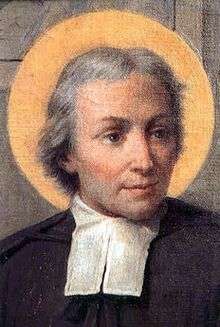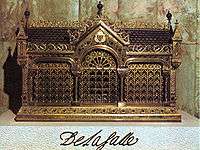Jean-Baptiste de La Salle
| Saint Jean-Baptiste de la Salle | |
|---|---|
 Official portrait of Saint John de La Salle | |
| Priest and founder of La Salle Schools and of the Brothers of the Christian Schools or FSC (Fratres Scholarum Christianarum) | |
| Born |
April 30, 1651 Reims, Champagne, Kingdom of France |
| Died |
April 7, 1719 (aged 67) Rouen, Normandy Kingdom of France |
| Venerated in | Roman Catholic Church |
| Beatified | February 19, 1888, Saint Peter's Basilica by Pope Leo XIII |
| Canonized | May 24, 1900, Saint Peter's Basilica by Pope Leo XIII |
| Major shrine | Sanctuary of John Baptist de La Salle, Casa Generalizia, Rome, Italy |
| Feast |
Church: April 7 May 15 (General Roman Calendar 1904-1969, and Lasallian institutions) |
| Attributes | Stretched right arm with finger pointing up, instructing one or two children standing near him, books |
| Patronage | Teachers of Youth, (May 15, 1950, Pius XII), Institute of the Brothers of the Christian Schools, Lasallian educational institutions, educators, school principals, teachers |
Saint John-Baptiste de la Salle (April 30, 1651 – April 7, 1719) was a French priest, educational reformer, and founder of the Institute of the Brothers of the Christian Schools. He is a saint of the Catholic Church and the patron saint for teachers.
De La Salle dedicated much of his life to the education of poor children in France; in doing so, he started many lasting educational practices. He is considered the founder of the first Catholic schools.
Background
De La Salle was born to a wealthy family in Rheims, France on April 30, in 1651. He was the oldest child of Louis de La Salle and Nicolle Moet de Brouillet. Nicolle's family was a noble one and ran a successful winery business and she was a relative of Claude Moët, founder of Moët & Chandon.[1]
La Salle received the tonsure at age eleven and was named canon of Rheims Cathedral when he was sixteen.[2] He was sent to the College des Bons Enfants, where he pursued higher studies and, on July 10, 1669, he took the degree of Master of Arts. When De La Salle had completed his classical, literary, and philosophical courses, he was sent to Paris to enter the Seminary of Saint-Sulpice on October 18, 1670. His mother died on July 19, 1671, and on April 9, 1672, his father died. This circumstance obliged him to leave Saint-Sulpice on April 19, 1672. He was now twenty-one, the head of the family, and as such had the responsibility of educating his four brothers and two sisters. He completed his theological studies and was ordained to the priesthood at the age of 26 on April 9, 1678. Two years later he received a Doctorate in Theology.[3]
Sisters of the Child Jesus
The Sisters of the Child Jesus were a new religious congregation whose work was the care of the sick and education of poor girls. The young priest had helped them in becoming established, and then served as their chaplain and confessor. It was through his work with the Sisters that in 1679, he met Adrian Nyel. What began as a charitable effort to help Adrian Nyel establish a school for the poor in De La Salle's home town gradually became his life's work. With De La Salle's help, a school was soon opened. Shortly thereafter, a wealthy woman in Rheims told Nyel that she also would endow a school, but only if La Salle would help.[4]
Institute of the Brothers of the Christian Schools
_15.jpg)
At that time, most children had little hope for social and economic advancement. Jean Baptiste de la Salle believed that education gave hope and opportunity for people to lead better lives of dignity and freedom. Moved by the plight of the poor who seemed so "far from salvation" either in this world or the next, he determined to put his own talents and advanced education at the service of the children "often left to themselves and badly brought up".[2]
La Salle knew that the teachers in Reims were struggling, lacking leadership, purpose, and training, and he found himself taking increasingly deliberate steps to help this small group of men with their work. First, in 1680, he invited them to take their meals in his home, as much to teach them table manners as to inspire and instruct them in their work. This crossing of social boundaries was one that his relatives found difficult to bear. In 1681, De La Salle realized that he would have to take a further step – he brought the teachers into his own home to live with him. De La Salle's relatives were deeply disturbed, his social class was scandalized. When, a year later, his family home was lost at auction because of a family lawsuit, De La Salle rented a house into which he and the handful of teachers moved.[5]
La Salle decided to resign his canonry to devote his full attention to the establishment of schools and the training of teachers. He had inherited a considerable fortune, and this might have been used to further his aims, but on the advice of a Father Barre of Paris, he sold what he had and sent the money to the poor of the province of Champagne, where a famine was causing great hardship.[6]
De La Salle thereby began a new religious institute, the first one with no priests at all among its members: the Institute of the Brothers of the Christian Schools,[2] also known as the De La Salle Brothers (in the U.K., Ireland, Malta, Australasia, and Asia) or, most commonly in the United States, the Christian Brothers. (They are sometimes confused with a different congregation of the same name founded by Blessed Edmund Ignatius Rice in Ireland, who are known in the U.S. as the Irish Christian Brothers.) The De La Salle Brothers were the first Roman Catholic teaching religious institute that did not include any priests.
One decision led to another until De La Salle found himself doing something that he had never anticipated. De La Salle wrote:
| “ | I had imagined that the care which I assumed of the schools and the masters would amount only to a marginal involvement committing me to no more than providing for the subsistence of the masters and assuring that they acquitted themselves of their tasks with piety and devotedness ...[3] Indeed, if I had ever thought that the care I was taking of the schoolmasters out of pure charity would ever have made it my duty to live with them, I would have dropped the whole project. ... God, who guides all things with wisdom and serenity, whose way it is not to force the inclinations of persons, willed to commit me entirely to the development of the schools. He did this in an imperceptible way and over a long period of time so that one commitment led to another in a way that I did not foresee in the beginning. | ” |
De La Salle's enterprise met opposition from the ecclesiastical authorities who resisted the creation of a new form of religious life, a community of consecrated laymen to conduct free schools "together and by association". The educational establishment resented his innovative methods.[6] Nevertheless, De La Salle and his Brothers succeeded in creating a network of quality schools throughout France that featured instruction in the vernacular, students grouped according to ability and achievement, integration of religious instruction with secular subjects, well-prepared teachers with a sense of vocation and mission, and the involvement of parents.[7]
In 1685, De La Salle founded what is generally considered the first normal school — that is, a school whose purpose is to train teachers — in Rheims, France.[8]
Worn out by austerities and exhausting labors, De La Salle died at Saint Yon, near Rouen, early in 1719 on Good Friday, only three weeks before his 68th birthday.[9]
Veneration

Pope Leo XIII canonized him on 24 May 1900 and Pope Pius X inserted his feast in the General Roman Calendar in 1904 for celebration on 15 May. Because of his life and inspirational writings, Pope Pius XII proclaimed him patron saint of teachers on 15 May 1950.[9] In the 1969 revision of the Church calendar, Pope Paul VI moved his feast day to 7 April, the day of his death or birth to heaven, his dies natalis.
Legacy
De La Salle was a pioneer in programs for training lay teachers. Of his writings on education, Matthew Arnold remarked: “Later works on the same subject have little improved the As of 2017, about 3,800 Brothers and 92,000 lay and religious colleagues worldwide were serving as teachers, counselors, and guides to 1,000,000 students in over 1,500 educational institutions in 77 countries.[8]
A number of streets have been named after La Salle, generally due to the presence of a Lasallian School. These include: in Bacolod, Philippines (where the University of St. La Salle and St. Joseph School - La Salle are located); and La Salle Street in Mandaluyong City. There is also De La Salle Avenue in St. Louis, Missouri; La Salle Road in Hong Kong; and La Salle Road in Towson, Maryland. In Malaysia that has 44 La Salle schools, in the state of Penang is a road named Jalan (meaning road in the Malay language) La Salle after a school that was there.
Many educational institutions around the world are named after him. For lists of these schools, see La Salle High School, De La Salle University-Manila, De La Salle College, De La Salle Academy, De La Salle School, or La Salle College High School.
See also
References
- ↑ Van Grieken, G. (1995). To Touch Hearts - Pedagogical Spirituality and St. John Baptist de La Salle (Doctoral dissertation). Boston College, Chestnut Hill, Massachusetts.
- 1 2 3 "St. John Baptist de La Salle", La Salle.org
- 1 2 Graham, Matthias. "St. John Baptist de la Salle." The Catholic Encyclopedia. Vol. 8. New York: Robert Appleton Company, 1910. 2 Feb. 2013
- ↑ Wanner, R., Claude Fleury (1640-1723) as an Educational Historiographer 1975 "No survey of French education in the seventeenth century would be complete without reference to the educational work of Jean-Baptiste de La Salle."
- ↑ "John Baptist de La Salle: His Life and Times", Signs of Faith, Winter 2000, De La Salle Institute Archived July 17, 2012, at the Wayback Machine.
- 1 2 "St. John Baptist de La Salle", Lives of Saints, John J. Crawley & Co., Inc.
- ↑ "An Innovative Pedagogy", La Salle France
- 1 2 "Discover the Priesthood", Diocese of Jefferson City, Missouri at the Wayback Machine (archived October 29, 2013). Archived from the original on 2013-10-29.
- 1 2 "Saint Jean-Baptiste de La Salle", nominis.cef
Further reading
- Salm FSC, Luke, The Work Is Yours: The Life of Saint Jean Baptist de La Salle, Christian Brothers Publications, 1989
- Van Grieken FSC, George, "Touching the Hearts of the Students: Characteristics of Lasallian Schools", Christian Brothers Conference, 1999.
- Koch, Carl; Calligan FSC, Jeffrey; Gros, Jeffrey, "John Baptist de La Salle: The Spirituality of Christian Education", Paulist Press, 2004.
- Calcutt FSC, Alfred, "De La Salle: A City Saint and the Liberation of the Poor Through Education", De La Salle Publications, Oxford. 1993.
External links
- Virtual Pilgrimage of De La Salle's Life official website
- Lasallian Resource Center - Website portal
- De La Salle Christian Brothers worldwide official website
- The Vocation of the Brothers United States & Canada
- Complete works of St John Baptist de La Salle PDF format
- Founder Statue in St Peter's Basilica
| Wikimedia Commons has media related to Saint Jean-Baptiste de la Salle. |